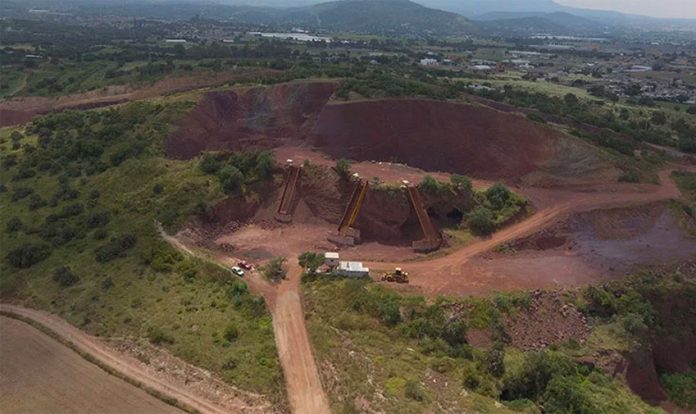More than half of the quarries that supplied the volcanic rocks tezontle and basalt for the construction of the new Mexico City International Airport (NAIM) operated illegally between 2016 and 2018.
An investigation by the newspaper El Universal determined that 106 of 205 quarries located in 24 México state municipalities near the abandoned airport site in Texcoco violated the law.
Published on Monday and based on a range of evidence including all quarry authorizations that were granted in the state between 2016 and 2018, the report said that 26 quarries operated without ever having authorization from the federal Environment Secretariat, 54 began mining for tezontle and basalt several months before they had permission to do so and 26 extracted rocks from areas beyond where they were authorized to mine.
Tezontle and basalt were used to build the foundations of the X-shaped terminal building and three runways at the site of the airport project, which was cancelled by President López Obrador following a controversial and legally questionable public consultation last October.
The volcanic rock foundations were designed to ensure that the airport didn’t sink on the unstable land of the ancient Texcoco lake.
El Universal also said that the quarries exploited the hills on which they were located to such an extent that they were transformed into deep red craters.
Mining for the volcanic rocks destroyed archaeological sites protected by the National Institute of Anthropology and History, wreaked havoc on ecosystems and denuded land of flora, leaving it as sterile desert, the report said.
In addition, the operation of the quarries led to an increase of crime, caused respiratory illnesses among all sectors of the population from children to the elderly and provoked conflicts among neighbors.
Between December 2015 and the public consultation of October 2018, the federal government awarded six contracts for the construction of the bulk of the airport project including the three runways and several buildings.
In the same period, companies sought a total of 189 permits from the Environment Secretariat to mine volcanic rock deposits in the area surrounding the airport site. Only 14 of the permit requests were denied, El Universal said.
The majority of the mining authorizations were approved within 12 months after September 2016, the month in which contracts for the construction of the runways were awarded.

El Universal determined that 75% of the tezontle that passed through one airport entry point in 2018 came from quarries that were operating, or had operated, illegally.
Sources told the newspaper that it was common for small and medium-sized quarries to sell the rocks they extracted to larger companies that took them to the airport site.
Among the owners of the quarries that supplied rocks to the US $13-billion project are local caciques (strongmen) who were allegedly friends of former president – and former México state governor – Enrique Peña Nieto, politicians, unions and even a narco from Tamaulipas, El Universal said. Some of the quarries are registered in the names of prestanombres, or front men.
López Obrador pledged to cancel the airport during last year’s election campaign on the grounds that it was corrupt, too expensive, not needed and geologically unsound.
His four-day consultation in October 2018 found 69.9% support to scrap the project and instead convert the Santa Lucía Air Force Base into a commercial airport and upgrade the existing airport in Mexico City and that in Toluca.
Communications and Transportation Secretary Javier Jiménez Espriú announced in August that the government had paid out more than 71 billion pesos (US $3.6 billion) to settle contracts for the canceled project.
However, construction at Santa Lucía has been held up by legal challenges filed by the #NoMásDerroches (No More Waste) collective, part of a strategy to revive the Texcoco project, which it believes is still possible.
The government intends to convert the airport site and surrounding areas into a massive ecological park and López Obrador said on Friday that the injunctions against the Santa Lucía project are being dealt with and that there would soon be “no legal obstacle” to its construction.
He also dismissed a claim made in a newspaper column that the government of Singapore was interested in presenting a proposal to complete the abandoned airport.
“I don’t think this proposal is true,” López Obrador told reporters at his regular news conference. “I think it’s an opinion like many others. I don’t think it’s a serious proposal.”
Source: El Universal (sp), Infobae (sp), Reuters (en)
